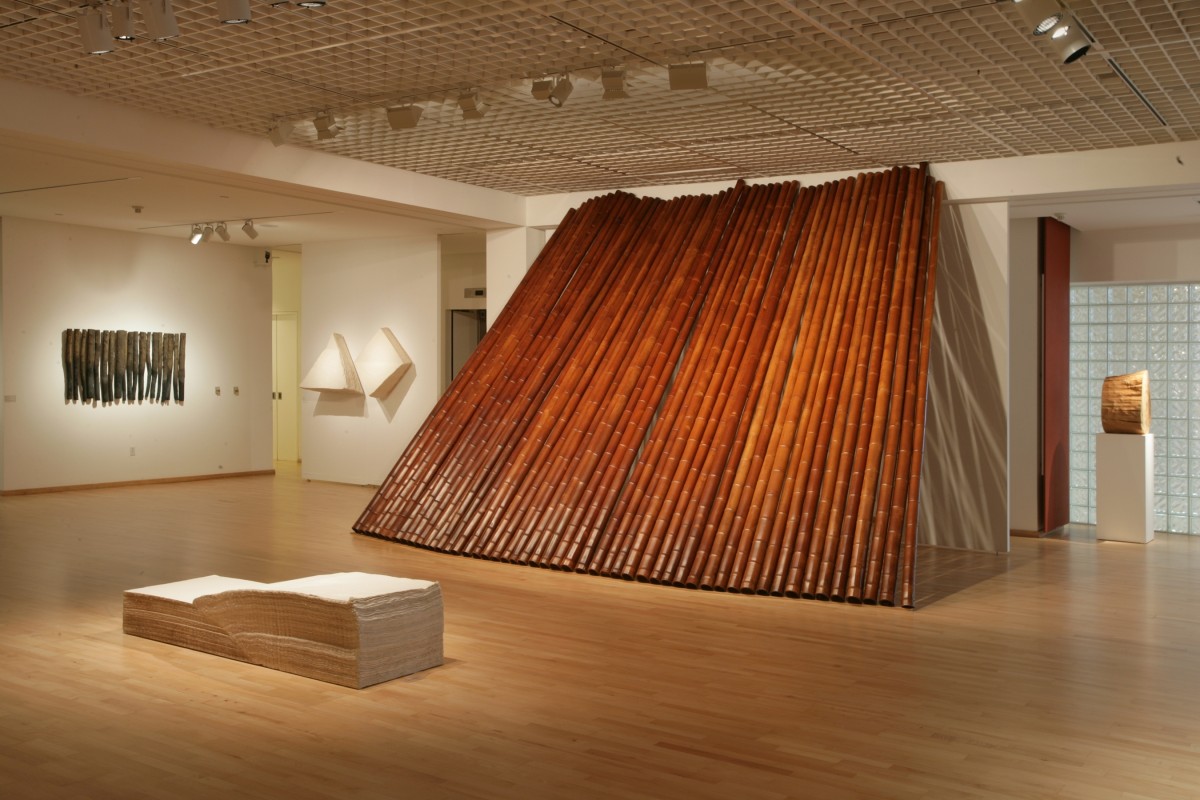An exhibition of sculptures fashioned from glass, wood, paper and bamboo.
When Kazuo Kadonaga started to make art seriously in 1971, he first chose to work with wood. He had been familiar with this material since childhood, because his family ran a lumber mill. Kadonaga devoted his efforts to creating a system that would reveal the material composition of wood. He did not choose special varieties of wood but worked with kinds used in everyday life. He began by slicing squared-off logs with a veneer slicer, the same machine used to make thin sheets of wood for plywood production. He then stacked these thin slices to recreate the original form of the squared-off log. After natural drying, the wood began to warp, revealing its invisible material properties as outward changes in form.
In his paper works, he made a stack of many pieces of handmade paper and puts it under a press while it is still drying. He then separated the sheets on one side. The contrast between the thin sheets on one side—what is ordinarily thought of as the natural form of paper, and the block of paper that remains compressed on the other side is an effective demonstration of the physical qualities of paper. The parts of the sheets that were peeled apart swelled naturally because of the resilience of the fibers. These paper works also showed the composition of the material in a clearly visible way.
Also on view were three large glass sculptures. After the raw materials of ordinary plate glass were melted in a furnace, a fixed amount of melted glass flowed continuously from a narrow spout into an annealing oven below it over a period of 48 hours. The sculptural form was created by gravity and the viscosity of the melted glass. In the annealing oven, the temperature was gradually reduced to prevent cracks in the mass of glass. It was necessary to wait 100 days before the work can be removed from the oven. This demanding process required large-scale facilities. It was entirely controlled by computer, and human workers only took part by putting the raw materials into the furnace and checking the temperature.
The finished mass of glass immediately revealed the material properties of glass to the viewer. In these works, Kadonaga revealed the physical nature of glass as such, including its internal characteristics. They were markedly different from previous abstract glass sculpture.
The exhibition included a group of fifty 15-foot lengths of honey-colored bamboo, propped against a wall. Their color, produced by kiln drying, was another example of Kazuo Kadonaga's interest in the natural transformation of materials with which he works. He said, "Throughout my career as an artist I have been more interested in exploring the inherent qualities of materials found in everyday life and developing systems that transform these materials naturally, rather than self-consciously creating beautiful 'art' objects."
Accompanying the exhibition were Kazuo Kadonaga—Wood / Paper / Glass 1975-1984, published by SPACE Los Angeles, 1985 and KAZUO KADONAGA, published by the Japanese American Cultural and Community Center, Los Angeles, 2001.
Playing continuously throughout the run of the exhibition was the ten-minute, videotape “Kazuo Kadonaga, Glass Piece no. 4,” showing the making of his distinctive sculpture.
